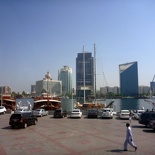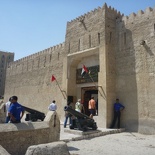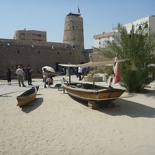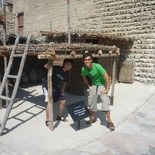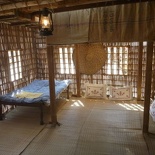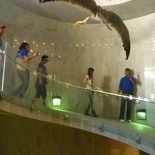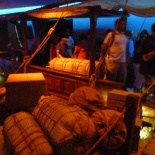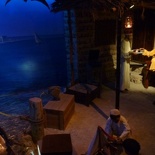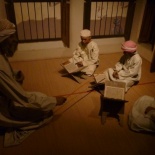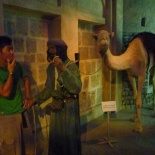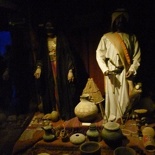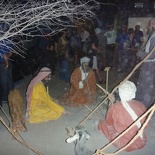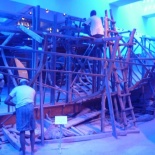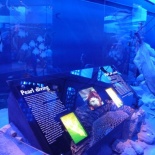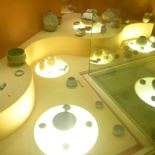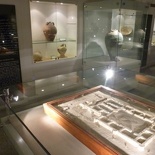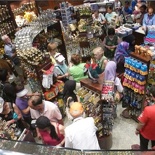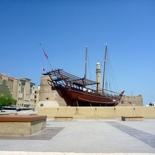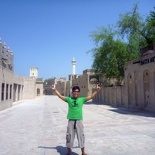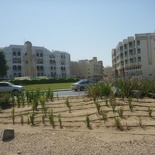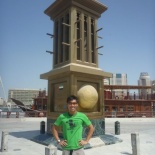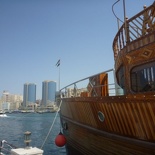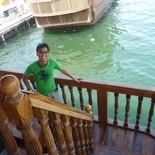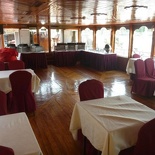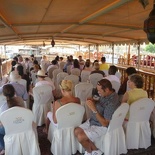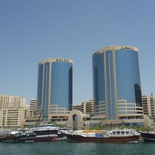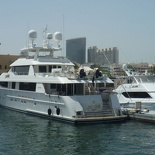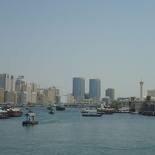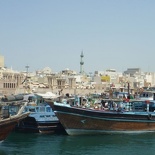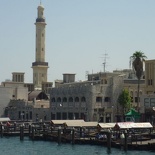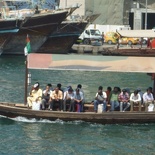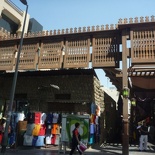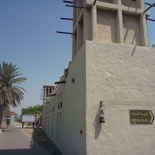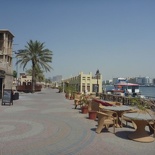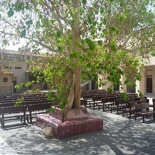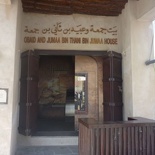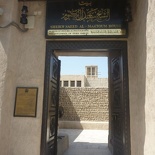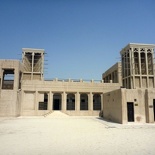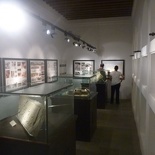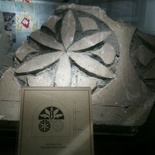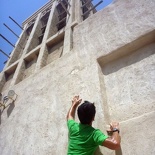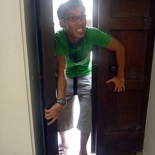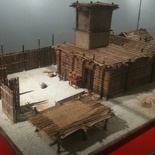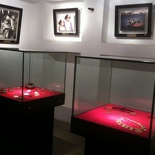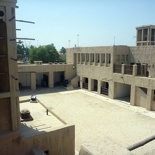This part of my Dubai trip focuses on the historical and heritage of the people here in the UAE. Places of interests here will be various heritage centers and museums of historical significance to the culture of the Dubai people. This experience is topped with a traditional Dhow river cruise down the Dubai creek right in the heart of Old Dubai.
First stop, the Dubai Museum! Located in the Al Fahidi Fort right in downtown Old Dubai, it is the oldest existing building in Dubai. The fort, built in 1787 features a front facade of cannons and is situated not far off the Dubai creek area. This creek itself is a major location for the gulf sea trade back in the early days of the town and even today. Having said that, acknowledging the contributions of the Dhow and the Creek of the early days, an iconic and distinctive full traditional Dhow can be seen on permanent display just outside the museum.
Upon entry to the museum courtyard, you will be greeted by a sand-filled little village, typical of the in Dubai during the early days and reflective of the lifestyle the people had at that time with living in the desert by the Creek.
Much of the displays and mock-up hut homes are exact replicas of the living conditions back then. Complete with soft beds and straw lined mats and walls. The wooden straw houses does a good job in keeping the glaring sun out, but not the heat, which seem to linger with the wind blowing through the area- which is uncomfortably all desert hot and dry and wicks aways any water in sight. The mud and clay houses on the other hand does a better job in insulation and keeping the heat out, on top of maintaining humidity at the expense of a darker and more earthy-damp smelling atmosphere. Some parts of the fort are air-conditioned display areas, showcasing pottery and various aspects of the upper fort in the early days.
You start the underground tour of the museum into the world of air-conditioned comfort from an entrance on the south-western corner of the fort. It’s from this single entrance here too, where you embark on the decent underground via a round spiral slope into a fishing port of the early world of Dubai.
Having said that, you will be brought through displays of early Old Dubai, particularly that through an Arabian marketplace, souks as well as the Creek side, where much trading over the Persian gulf was done then. There were accurate re-productions of food stalls decked with store owners, shipping merchants as well as the gulf traders which fueled the booming pearl trade then. Elaborating the displays are narrations and signages touching on the past developments and history of the Creek itself.
The displays also provides a peek into the domestic life of the area, through societal and social interactions through villages, homes and schools alike. All decked out with mannequins and even animal replicas- showcasing an era long forgone all frozen and captured in time at the museum. There were few archaeological finds of the fort on display too, mainly early day pottery and cutlery used by the townsfolk.
Besides cross gulf trade, fishing and pearl diving were also big things at the creek back then. Seasoned free divers search the sea for worthy oysters bearing good pearls of the trade. Often coming with bragging rights as the job is a respected and often high risk one, often yielding high gains to offset the risks involved- only the the best and fittest free-diving pearl divers having the luxury of finding the best loot under the sea.
Dhow boat building is an art too, with a strict set of workmanship procedures and standards in which the boats were produced back then. Dhows today are still in fact still constructed via the similar proven techniques as of the yesteryear, only with the current utilization of more modern and synthetic materials. This is done to prolong the active lifespan of the modern Dhow, yet retaining much of the iconic style, shape and handling of the boat.
The displays then move further onto the traditional burial rites as well as the more prized archaeological displays particularly those in display in the Sheikh mohammed bin Rashid al Maktoum hall. The tour through the whole museum is pretty much a linear one-way route and can be covered in about 2 hours the most, with the tour exiting right out of the museum and back onto the streets after passing-by the museum’s giftshop.
Interestingly on this part of town, you can get few good scenes of the region-wide surface sprinkler system which I mentioned on my earlier blog post. These water carrying hoses runs under all the greenery here in Dubai, providing cooling and water to much needed vegetated areas. It’s nearly impossible for any vegetation here to thrive under the hot and dry climate of the middle east, thus the ingenuity of the underground watering system.
There are few markets around the area where the museum reside, particularly the Bastakia souks which is just a short walk through the buzzing town. Heading further north will bring you up to the Dubai creekside where we will be boarding our Dhow river cruise for the afternoon. The creekside is essentially a long paved walkway which runs along side the Dubai creek and is home to the Creekside Wind Tower Monument which is essentially a replica of the traditional cooling wind funnels used to in the traditional clay and mud houses here.
The creekside despite being a major port in the early days and a tourist attraction is surprisingly devoid of people in the day. It’s simply just to hot to get anything done out here in the day. Even most ships here across the gulf do much of their work and unloading here in the night which is surprisingly a much more bearable condition to work in. The daytime here by the creek is simply just too hot and literally just offers a lazy walk down the bayside. With that, the creekside is mostly all peacefully quiet with the breeze whistling past your ears and the faint smell of the heated brick floor and salt from the seawater. This silence of course broken with an occasional snoring fishermen on their Dhow boats and some traffic passing through the nearby roads.
The river is home to many Dhows and private Yachts all berthed alongside the Creekside. It seems that berthing on the southern banks are usually preferred by yacht owners and away from the busier northern banks, no telling how much does it cost to have your boat here for a day, but it shouldn’t be cheap. We started of the Dhow cruise by heading eastwards towards Port Saeed passing several iconic sights such as the Rolex Towers and the Al Bastakiya along the way, before making a U-turn and thereafter heading west towards the creek mouth towards the Dubai heritage center.
The view of the city from the creek itself puts you in the center of the spot, offering rather unique views you can never get from either end of the creek bankside. The boat carries on the tour through the creekside souks, allowing you to actually grasp the size of the marketplace and the density of the souk buildings packed so closely together- seemingly (and literally) packed denser and tighter than a can of sardines.
Places of interest here will include the spice and textile souks we visited the day before as well as the Lord Shiva Temple with it’s distinctive tall spires by the Creek river. The channel itself is home to huge number of Dhows particularly on the northern banks where the main market reside. In contrast to the southern banks where we broaded the cruise, the western channel is buzzing with life even on the hot midday.
It’s also on this part on the west creek where you can spot many active water buses zipping across the creek, all of them packed to the brim with passengers. These water taxis, together with the larger mass-transport water ferries serve as the primary means of river crossing for the locals here, with the latter operated by the Baniyas Marine Transport Station.
While the larger ferries are fixed by departure timings, the smaller rengegade like river taxis operate independently with flexible departures depending on when their boats are able to take on any more passengers. These taxis operate both in the day and night, and riding on one of these is an experience itself. It’s almost literally crossing the creek on floats with an engine attached at no more of a bargain of 5AED a trip, safety line not included, just hang on!
Our next stop on our historical tour will be the Dubai Heritage center, located on the southern banks of the creek just north of the textile souks. The heritage center spots a showcase of traditional Arabian housing, tents and mud houses alike all set in a small village atmosphere. The center moreover, is built alongside the creek with a creekside broadwalk to boot, complete with bayside restaurants, souvenir stores and cafes, which is not surprisingly devoid of any people at all. Maybe this place is more of a night hangout. There are few open air amphitheaters- nice, some college buildings and some pay-to-enter museums, but there is just nobody here at all, it’s just like a ghost town.
Suited here along the Dubai Creek in the locality of Al Shindagha on the heritage center grounds is the Sheikh Saeed Al Maktoum house. It was established around 1894 as the seat of the Al Maktoum family and former residential quarters of Saeed bin Maktoum Al Maktoum, former ruler of Dubai in the United Arab Emirates. The building is now a historic building and museum containing many historical Arabian artifacts as well as an extensive collection of images of old town Dubai.
The exhibits goes about as a showcase of the people, traditions, and history of the creekside. On display are some early drawn maps of the region, as well as traded currency, affiliations and trade agreements across the gulf. Notably those with Britain’s East India Company, which had established trading links with the Gulf as early as 1616. Miscellaneous displays include a peek into early day agriculture, development and architecture of the city, with some building fixtures preserved and laid within the compounds of the site itself, which are presumed to come from notable housing designs of the yesteryear.
Humorously, with the exception of the main entrance, the door and walkways of the house are extremely narrow, amusingly hobbit sized. Nested by the entrance is the museum’s general office, as well as a small cozy attraction giftshop.
The house itself spots a rather plain looking courtyard in the center with the compound buildings lined around and surrounding it. The general compound is made out of the traditional mud and clay decked with the iconic wind funnels on the roofs, keeping the estate cool in the hot summer months. These wind funnels here however are purely aesthetic and are non-functional now- they are all sealed and replaced with a more effective centralised air-conditioning which cools all the interior galleries in the entire museum. The upper level of the house is home to few rooms, a loft as well as a balcony offering an overlooking view of the Dubai creek looking eastward.
Okay, that is all for the historical sites in Dubai for now. The next part of my trip will be an exploration of Abu Dhabi!
- Dubai city sights Part 1 (Dubai city photo album)
- Dubai city sights, creek and souks Part 2
- The Dubai mall, aquarium and zoo (Dubai mall photo album)
- Up the Burj Khalifa (Photo sights up the Burj Khalifa)
- Dubai historical sites and Dhow River cruise (Historical site and Dhow cruise album)
- Dubai Desert Safari (Safari photo album)
- Adu Dhabi (Adu Dhahi photo album)
- Yas island (Yas island photo album)
- Jumeirah, Wadi wadi waterpark (Wadi wadi Photo album)

